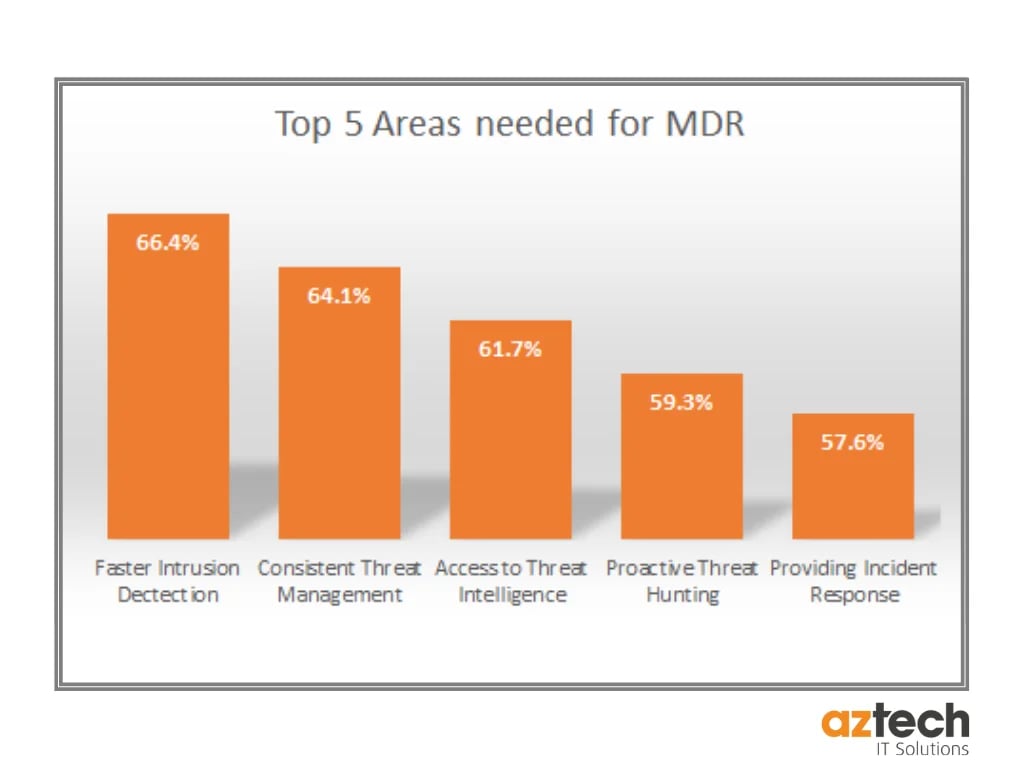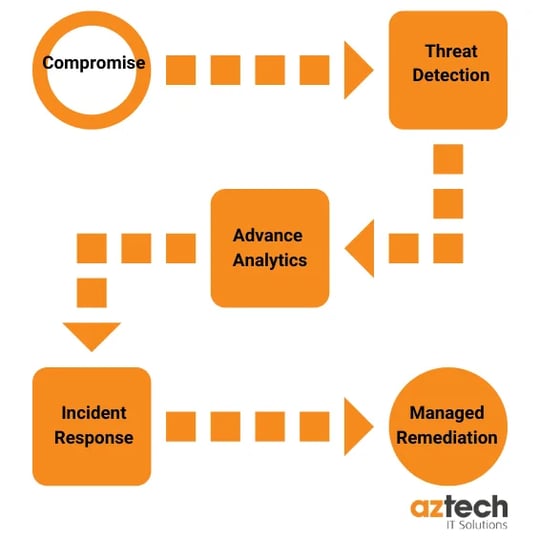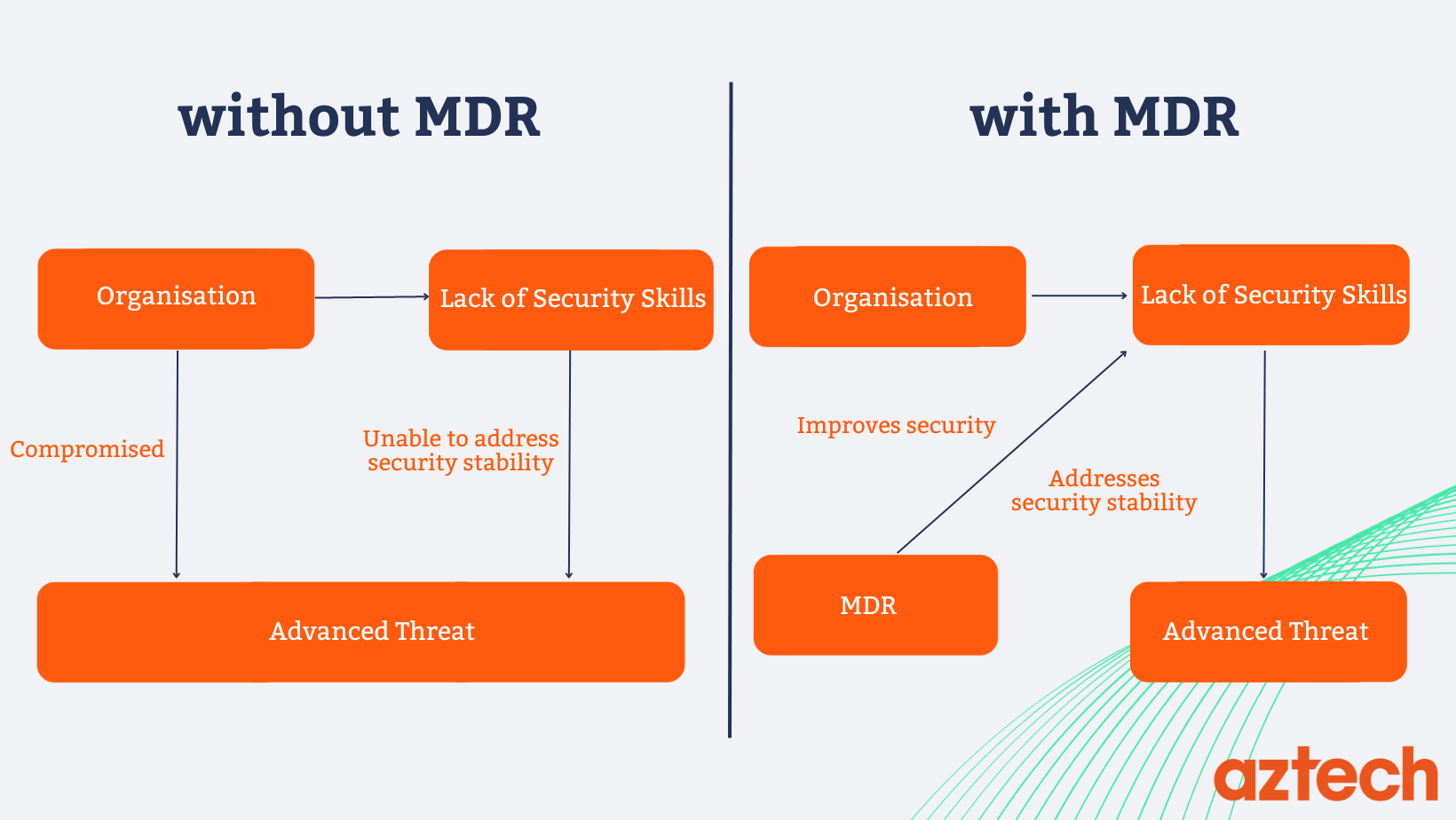Everything you should know about MDR Cyber Security
From data breaches to ransomware attacks, cyber security threat landscapes are constantly evolving and becoming more sophisticated, making it essential for companies of all sizes to invest in comprehensive security solutions by outsourcing some of it's security operations to an MDR security service provider.
If you're looking for innovative security technologies and security tools to detect and protect against malicious activities on your network, MDR security experts and solutions may be the perfect addition your organisation needs.

In this blog post, we'll break down everything you need to know about Managed Detection and Response (MDR): what is MDR cyber security, how does work to protect businesses, it's benefits, how response managed detection is different from other managed services and finally as a bonus, how you can choose an MDR - so that you can make an informed decision about whether this new approach could provide value for your business or organisation.
What is Managed Detection and Response (MDR) in Cyber Security?
Managed Detection and Response (MDR) is a type of cybersecurity service that focuses on continuous and proactive monitoring of IT systems to identify, isolate, and neutralise potential threats before they escalate by combination of advance technology stacks, like threat hunting and human expertise.
But what exactly is MDR cyber security? Think of it like a virtual bodyguard for your company's digital assets. MDR cyber security proactively detects, investigates, and responds to latest threats.

MDR vendors incorporate advanced technology like proactive threat hunting, human investigation and behavioural analysis to detect and actively respond to any suspicious activities before they can cause damage.
By choosing MDR solutions, businesses can get some help evolving adversarial tactics and techniques and knowing that their networks, cloud workloads, endpoints, servers, emails and systems are being watched over proactively by a threat intel team and security experts, so they can focus on their core business objectives.
How Does MDR Work to Protect Businesses from Cyber Threats?
Are you struggling to block threats? As technology advances and hackers become increasingly sophisticated, more companies are turning to an MDR solution to protect their networks from malicious attacks.
Let's explore the essential components of an MDR framework and how MDR cyber security works.
1. 24/7 Monitoring
One of the core capabilities of MDR cyber security is 24/7 network monitoring. This means that there will always be a security professional monitoring your network and cloud workloads for signs of intrusion or other security issues.
2. Advanced Analytics
With advanced analytics, your MDR IT security teams will use sophisticated security tools and techniques to analyse your data and identify patterns that may indicate an alert fatigue and security threat.
3. Threat Intelligence
In this evolving threat landscape, an MDR security team will have access to information about the latest known and unknown threats and will be able to provide you with guidance on how to best protect your security posture and network by threat intelligence and threat research.
4. Incident Response Capabilities
Your MDR security team will have a plan in place for how to rapidly respond to a security incident by managed remediation. This is important because it helps to have a comprehensive visibility on cloud environments, so you are able to quickly and effectively respond to any incidents that occur.
5. Forensics Analysis
The effective MDR vendor will have the ability to collect and analyse data from a security incident in order to determine what has happened and who was responsible.
This is important because it helps you investigate and understand any incidents that occur, which can help your in-house expertise prevent future incidents from occurring.
6. Reporting
Reporting helps you to keep your in house team updated with latest cyber security trends. Your MDR team will perform data analytics and generate reports on the status of your network and any security incidents that occur.
7. Support
This means that an effective MDR provider will provide you with a 24/7 Security Operations Centre (SOC) for your organisation with support such as technical assistance, response services and customer service.

What are the benefits of a Managed Detection and Response (MDR) service in cyber security?
Managing digital assets in an increasingly complex IT environment can be overwhelming, but having an effective MDR cyber security service is essential for keeping your data safe from suspicious activity and malicious actors.
Now, let's discuss the long-term benefits that MDR vendors offer and why you should invest in a comprehensive MDR solution today!
1. Early Detection of Cybersecurity Threats
One of the primary benefits of a Managed Detection and Response service is that it can help to detect cybersecurity threats early.
In addition, MDR cybersecurity experts use a variety of tools and techniques to monitor networks for signs of suspicious activity.
By detecting threats early, MDR services can help to prevent them from causing serious damage to company's security posture.
2. Quick Response to Cybersecurity Threats
Another benefit of MDR cyber security is that it can help you to quickly respond to cybersecurity threats.
Once a threat has been detected, MDR services can provide guidance on how to best mitigate it.
Additionally, managed remediation helps to responds to threat more effectively and restore endpoints to a know good status.
3. Improved Cybersecurity Posture
An MDR service can also help to improve an organization’s overall cyber security posture.
Also, by constantly monitoring networks and responding quickly to threats, MDR services can help organizations keep their systems secure.
Also, the use of an MDR can also help organizations meet compliance requirements.
4. Reduced Costs
By detecting and responding to threats quickly, MDR services can help to minimize the amount of damage that is caused.
Additionally, MDR services can also help organizations avoid the need for costly security repairs or replacements.
5. Increased Productivity
An MDR cyber security can also help to increase productivity by freeing up in house expertise that would otherwise be devoted to managing cybersecurity threats.
Also, by taking care of threat detection and response, an MDR service can allow organizations to focus on other tasks such as business continuity or incident response.
6. Enhanced Visibility into Cybersecurity Threats
Another benefit of an MDR cyber security is that it can provide enhanced visibility into cybersecurity threats.
And, by constantly monitoring networks, MDR can provide detailed information about the types of threat hunting that are present and how they are evolving over time.
What differentiates Managed Detection Response (MDR) from other Endpoint Solutions?
Are you operating a business and looking for the best endpoint security maturity solution to protect your data?
With so many options in the market, it can be hard to decide which one is right for your organization.
One of the newer offerings, MDR, has been gaining traction in recent years as an ideal solution for keeping threats at bay with it's security maturity teams.
But, what sets MDR apart from other endpoint solutions and how can you leverage its capabilities to maximize your security investments?
What is the difference between EDR and MDR?
If you're curious about the differences between Endpoint Detection and Response (EDR) and Managed Detection Response (MDR), you've come to the right place.
| SL. No. | EDR | MDR |
| 1. | Focuses on detecting and responding to threats on individual devices like laptops and servers. | More comprehensive as includes EDR as well as other technologies like threat hunting, incident response etc. |
| 2. | Provides real time monitoring | 24/7 security monitoring |
| 3. | Captures data on endpoint activities | Captures data 24/7 and response |
Endpoint Detection and Response (EDR) is a security solution that focuses on detecting and responding to threats on individual devices, such as laptops and servers.
It provides real-time monitoring and captures data on endpoint activities, giving security teams the visibility they need to respond swiftly to an attack.
On the other hand, Managed Detection Response (MDR) is a more comprehensive service that includes EDR but also incorporates other technologies and services, such as threat intelligence, threat hunting and incident response.
MDR providers usually offer 24/7 security monitoring and response, making it an excellent option for organizations that lack the resources or expertise to manage security in-house.
Ultimately, the main difference between EDR and MDR lies in the scope of their coverage and services.
What is EDR vs SIEM vs MDR?
Have you ever wondered what the major differences are between EDR, SIEM, and MDR?
Well, wonder no more! Each of these security solutions tackles threats in their unique way, making them pivotal in the battle against cybercrime.
Endpoint Detection and Response (EDR) primarily focus on identifying and responding to threats that breach security perimeters.
Meanwhile, Security Information and Event Management (SIEM) provides real-time analysis of security alerts generated by various network security solutions.
Lastly, Managed Detection and Response (MDR) combines human expertise and technology like threat intelligence to focus on detecting and responding to cyber threat hunting.
Remember, when it comes to cybersecurity, you cannot simply rely on one solution, and understanding these main differences puts you one step ahead in protecting your network.
What is MDR vs XDR?
Are you interested in understanding the difference between MDR and XDR?
MDR, or Managed Detection and Response, is a security service that provides organization's security teams with comprehensive and proactive threat hunting and response capabilities.
On the other hand, XDR, or Extended Detection and Response, is an evolution of MDR that enables security teams and security analysts for threat detection and responds to advanced threats across multiple security layers.
While both security events are designed to help organizations protect themselves from threats, XDR takes it a step further by offering integration with other security services such as endpoint detection and response, network detection and response, and more.
So, if you're looking for a more comprehensive cybersecurity tools and solution that extends beyond threat detection and response, XDR might be the way to go.
Cost Comparison between MDR and Other Forms of Endpoint Protection
There are a variety of endpoint protection services available to businesses today, each with their own unique costs and benefits. When it comes to cost comparison, MDR stand out as an affordable yet effective solution.
Compared to other options such as EDR, XDR, and SIEM services, MDR are often more budget-friendly while still providing top-notch protection against threats.
Don't let cost hold you back from securing your endpoints - explore the range of options available and consider if MDR cyber security services might be the right fit for your business.
What is MDR vs. MSSP?
MDR, or Managed Detection and Response, focuses on incident response and threat hunting. This means that any known and unknown threats are swiftly detected and addressed by a team of experienced security professionals.
On the other hand, an MSSP, or Managed Security Service Providers, offers a wider range of security services such as vulnerability scanning, alert fatigue, intrusion prevention, and compliance management.
The key difference between the two lies in their approach. MDR is more reactive, dealing with threats as they arise, while MSSPs are more proactive, focusing on preventing threats before they occur.
Why choose Managed Detection and Response (MDR) over Managed Security Service Providers (MSSPs)?
While many businesses turn to MSSP services for security support, opting for a Managed Detection and Response (MDR) service can offer numerous benefits.
With MDR service provider, you'll gain access to a dedicated Security Operations Center (SOC) that specializes in proactive threat hunting, guided response and managed remediation working to quickly detect and mitigate any potential threats to your organization.
This approach puts you in a better position to improve your security posture and detect threats before they escalate, ultimately helping to safeguard your organization's security.
How to Choose an Managed Detection and Response (MDR) Service?
1. Define Your Needs
You should consider what type of threats you are most vulnerable to, what level of protection you need, and what type of response you would like in the event of an attack.
Once you have a clear understanding of your needs, you will be able to narrow down your options and choose a service that is right for you.
2. Research Different Services
Once you have defined your needs, you can begin researching different MDR cyber security services. There are a variety of services available, so it is important to take the time to find one that meets your specific needs.
You can research services online, or you can speak to other businesses in your industry to see which ones they recommend.
3. Consider Your Budget
MDR cyber security services can vary significantly in price, so it is important to find one that provides affordable prices that fit within your budget.
You should also consider whether you need a long-term or short-term solution, as this can affect the cost of the service.
4. Compare Services
Once you have narrowed down your options, you can begin comparing different MDR.
You should compare the features of each service, as well as the price. It is also important to read reviews of each service before making your final decision.
5. Choose a Service Provider
There are a few things to consider when choosing a provider, such as their reputation, experience, and customer service.
You should also make sure that the provider offers a money-back guarantee in case you are not satisfied with the service.
6. Implement the Service
The provider will help you to set up the system and train your internal IT security team on how to use it.
It is important to make sure that everyone in your company knows how to use the system so that they can be prepared in the event of an attack.
7. Test the Service
After the MDR system has been implemented, it is important to test it regularly to ensure that it is working properly.
You should test the system by simulating different types of attacks and monitoring how well the system responds. This will help you to identify any weaknesses in the system so that they can be addressed.

-1.png?width=552&height=678&name=text-image%20module%20desktop%20(4)-1.png)


.png?width=2000&name=Case%20study%20(21).png)


-2.png?width=422&height=591&name=text%20image%20tablet%20(31)-2.png)

-2.png?width=1366&height=768&name=Blog%20Hero%20Banners%20(4)-2.png)
-2.png?width=1366&height=768&name=Blog%20Hero%20Banners%20(5)-2.png)



